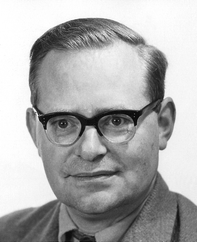John Frederick Grove 1921–2003
 | ||
| Plate1 John Grove | ||
John Grove joined the ICI laboratories at Jealott's Hill in 1944 and then, in 1946, he moved to the Butterwick Laboratories at The Frythe, Welwyn. These later became the Akers Research Laboratories. His physical organic chemistry background was reflected in his early research and was exemplified in a paper that he published in Chemistry and Industry in 1949 on the application of physical chemistry to the study of biologically-active compounds. In this paper, there were several applications of spectroscopic methods to the study of natural products. It was in the study of biologically-active microbial natural products at the Frythe that John Grove made his name. His research covered the transition between classical, often lengthy, chemical degradation and the application of modern, more rapid, spectroscopic methods. John Grove recognised the value of these methods and made significant contributions to this change. For example, the widely-used tables correlating the frequency of carbonyl absorption in the IR with the structure of the carbonyl component appeared first in Grove and Willis, J. Chem. Soc., 1951, 871. He applied the results in subsequent papers on patulin, hydroxyphthalides and terrein. The work with several collaborators, on gibberellic acid in the late 1950's made pioneering use of NMR spectroscopy in the determination of the structure of natural products and of ORD in determining absolute stereochemistry. John Grove made major contributions to the structure determination of a number of metabolites of plant pathogenic fungi including: gladiolic acid, frequentin, terrein, alternaric acid, griseofulvin, viridin, gibberellic acid and diacetoxyscirpenol. Both the antibiotic, griseofulvin, and the plant hormone, gibberellic acid, became commercial products. Many of his papers published during the 1960s revealed a talent for combining chemical and spectroscopic methods in structure determination. His work was characterized by its thoroughness and the attention which he paid to identifying all the products of a degradative sequence.
Although his name only appears on papers to which he made an experimental contribution, he made a much wider contribution to the planning of studies on the chemistry of microbial metabolites at the Frythe. As Head of the Organic Chemistry Department, he built up an effective team of organic chemists who worked in collaboration with microbiologists and plant pathologists. The closure of these laboratories in 1964 was a serious blow to him. For a few years he held a number of temporary positions at the London School of Hygiene and Tropical Medicine, the Tropical Products Institute and from 1968–1970 a Comyns-Berkley Bye Fellowship at Gonville and Caius College in Cambridge. He joined the ARC Unit of Invertebrate Chemistry and Physiology at Sussex in 1970 as a Principal Scientific Officer and he was made an Honorary Reader at the University of Sussex. He continued to work on fungal metabolites, particularly from fungi associated with insects. As he put it, the compounds were the same but the bioassay was different. During this time he made some useful contributions to the microbiological chemistry of Dutch Elm disease, its vectors and the phomopsolide feeding deterrents and on entomopathogenic fungi studying the complex depsipeptides produced by Beauvaria species and the metabolites of Verticillium lecanii. The chemistry of the trichothecene mycotoxins is dominated by intramolecular cyclizations and rearrangements and John Grove uncovered a number of these. He became an acknowledged expert on these mycotoxins. When he retired in 1982 from the AFRC, he continued to work at Sussex on the chemistry of fungal metabolites until the financial constraints of the University brought this to an end. However he actively followed the progress of natural product chemistry and right up to the time of his death, he was a familiar figure in the library at Burlington House.
John Grove was a man of absolute integrity. He was a very private, shy man but not without a sense of humour. He rarely described his work in public. He enjoyed the visual arts, the theatre, walking, watching cricket and supporting Yorkshire. He was a single man of very regular habits and he had lived in the same flat in Welwyn Garden City for over fifty years. He died after a short illness in Hemel Hempstead hospital on the 22nd October, 2003.
Margaret M. Blight,
Rothamsted Research, Harpenden, Herts, AL5 2JQ
James R. Hanson
University of Sussex, Brighton, Sussex, BN1 9QJ
| This journal is © The Royal Society of Chemistry 2004 |
